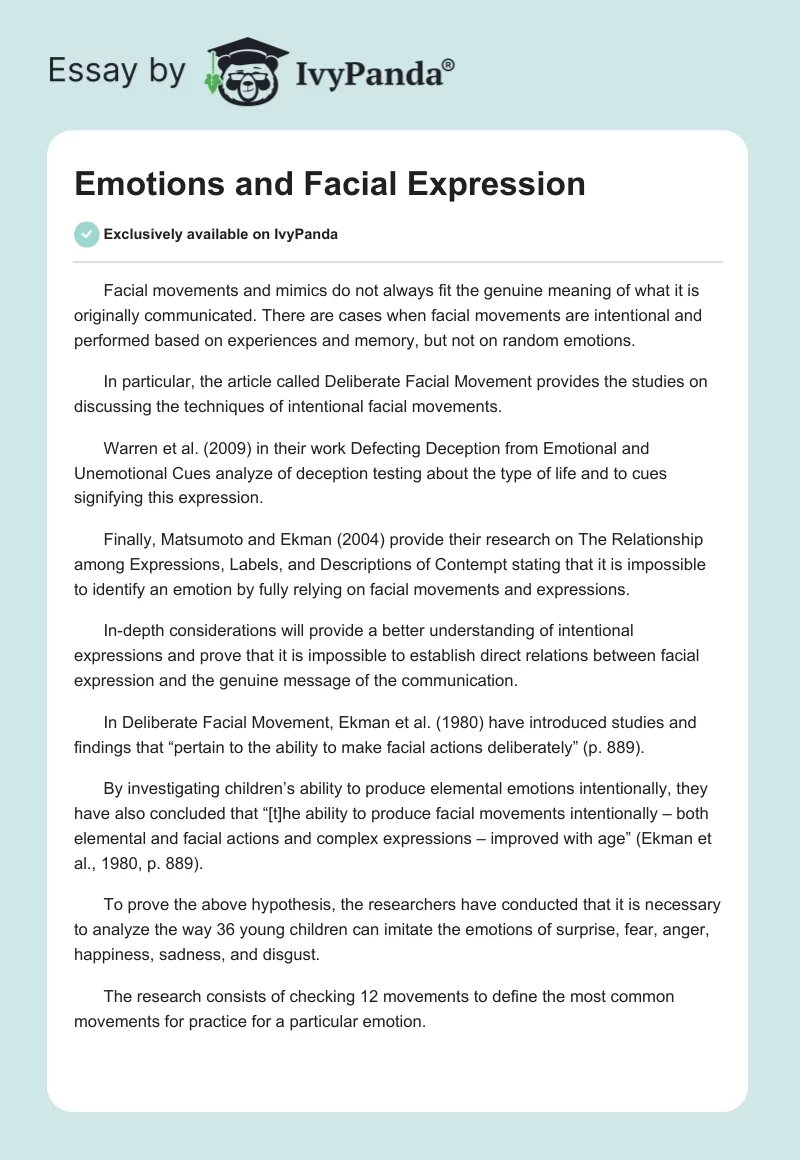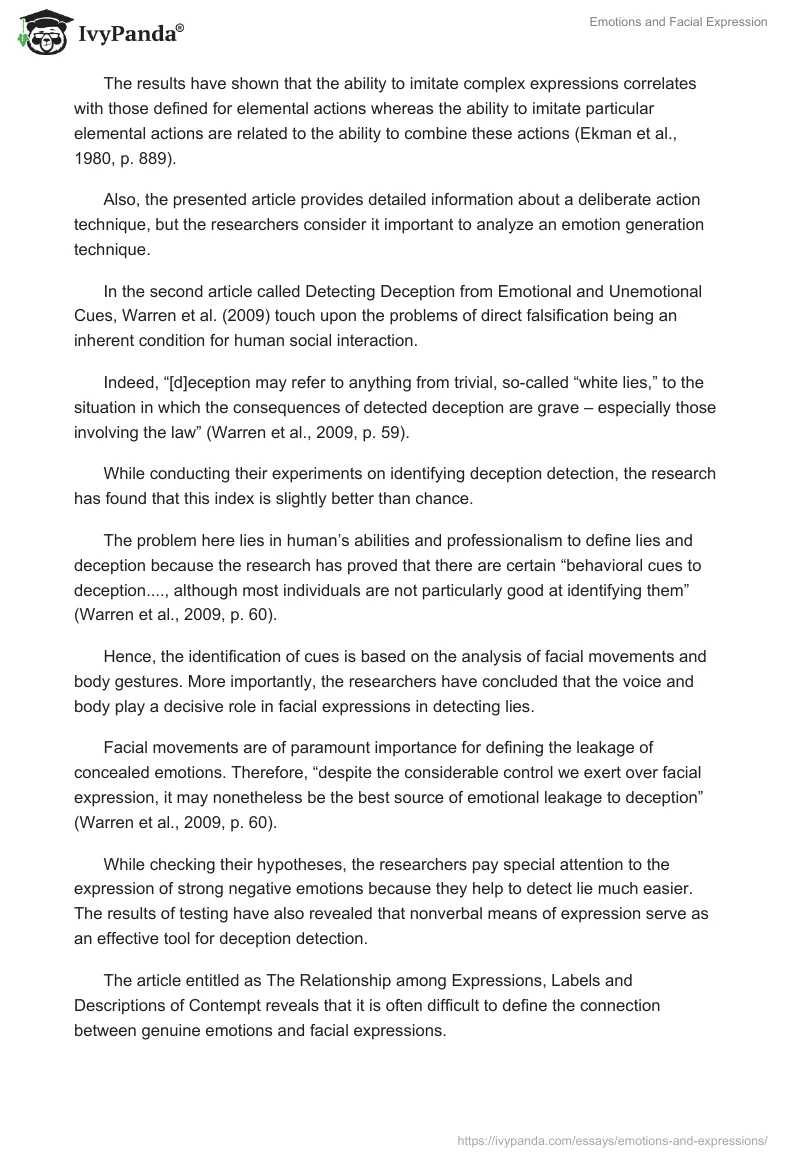Facial movements and mimics do not always fit the genuine meaning of what it is originally communicated. There are cases when facial movements are intentional and performed based on experiences and memory, but not on random emotions.
In particular, the article called Deliberate Facial Movement provides the studies on discussing the techniques of intentional facial movements.
Warren et al. (2009) in their work Defecting Deception from Emotional and Unemotional Cues analyze of deception testing about the type of life and to cues signifying this expression.
Finally, Matsumoto and Ekman (2004) provide their research on The Relationship among Expressions, Labels, and Descriptions of Contempt stating that it is impossible to identify an emotion by fully relying on facial movements and expressions.
In-depth considerations will provide a better understanding of intentional expressions and prove that it is impossible to establish direct relations between facial expression and the genuine message of the communication.
In Deliberate Facial Movement, Ekman et al. (1980) have introduced studies and findings that “pertain to the ability to make facial actions deliberately” (p. 889).
By investigating children’s ability to produce elemental emotions intentionally, they have also concluded that “[t]he ability to produce facial movements intentionally – both elemental and facial actions and complex expressions – improved with age” (Ekman et al., 1980, p. 889).
To prove the above hypothesis, the researchers have conducted that it is necessary to analyze the way 36 young children can imitate the emotions of surprise, fear, anger, happiness, sadness, and disgust.
The research consists of checking 12 movements to define the most common movements for practice for a particular emotion.
The results have shown that the ability to imitate complex expressions correlates with those defined for elemental actions whereas the ability to imitate particular elemental actions are related to the ability to combine these actions (Ekman et al., 1980, p. 889).
Also, the presented article provides detailed information about a deliberate action technique, but the researchers consider it important to analyze an emotion generation technique.
In the second article called Detecting Deception from Emotional and Unemotional Cues, Warren et al. (2009) touch upon the problems of direct falsification being an inherent condition for human social interaction.
Indeed, “[d]eception may refer to anything from trivial, so-called “white lies,” to the situation in which the consequences of detected deception are grave – especially those involving the law” (Warren et al., 2009, p. 59).
While conducting their experiments on identifying deception detection, the research has found that this index is slightly better than chance.
The problem here lies in human’s abilities and professionalism to define lies and deception because the research has proved that there are certain “behavioral cues to deception…., although most individuals are not particularly good at identifying them” (Warren et al., 2009, p. 60).
Hence, the identification of cues is based on the analysis of facial movements and body gestures. More importantly, the researchers have concluded that the voice and body play a decisive role in facial expressions in detecting lies.
Facial movements are of paramount importance for defining the leakage of concealed emotions. Therefore, “despite the considerable control we exert over facial expression, it may nonetheless be the best source of emotional leakage to deception” (Warren et al., 2009, p. 60).
While checking their hypotheses, the researchers pay special attention to the expression of strong negative emotions because they help to detect lie much easier. The results of testing have also revealed that nonverbal means of expression serve as an effective tool for deception detection.
The article entitled as The Relationship among Expressions, Labels and Descriptions of Contempt reveals that it is often difficult to define the connection between genuine emotions and facial expressions.
A detailed overview of previous researchers has proved that “participant recognize contempt expressions accurately when judged within a wide range of other emotional expressions.”
Also, the failure of some studies to define the expression of contempt is explained by the fact that the researchers have not managed to widen their choice of cues and labels for identifying this emotion (Matsumoto and Ekman, 2004, p. 535).
As proof, there are other related studies dedicated to the analysis of the contempt expression through different combination of other emotions. Despite a low level of accuracy, there are still solid arguments supporting the relation between emotions and facial movements.
One way or another, the article reveals two-polar apposition to the presented issues. On the one hand, the contempt expression has been recognized as a cue for the contempt emotion in many cultures’.
On the other hand, some studies have shown that “the contempt expression is not reliably recognized as contempt, providing fuel for the speculation that the contempt expression is not a signal of contempt” (Matsumoto and Ekman, 2004, p. 538).
Based on the article and studies presented in them, it should be concluded that emotions and facial expression do not always correlate. Therefore, they prove human’s ability to deceive their genuine emotions and communication messages with the help of deliberate facial movements.
Reference List
Ekman, P., Roper, G., and Hager, J. C. (1980). Deliberate Facial Movement. Child Development. 51, pp. 886-891.
Matsumoto, D. and Ekman, P. (2004). The Relationship among Expressions, Labels, and Descriptions of Concept. Journal of Personality and Social Psychology. 87(4), pp. 529-540.
Warren, G., Schertler, E., and Bull, P. (2009). Detecting Deception from Emotional and Unemotional Cues. Nonverbal Behavior. 33, pp. 59-69.


